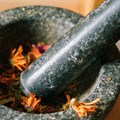Other reasons include affordability, accessibility, patient dissatisfaction with conventional medicine, and the common misconception that “natural” is “safe”.
The growing recognition of traditional medicine resulted in the first World Health Organization global summit on the topic, in August 2023, with the theme “Health and Wellbeing for All”.
Traditional medicines are widely used in South Africa, with up to 60% of South Africans estimated to be reliant on traditional medicine as a primary source of healthcare .
Conventional South African healthcare facilities struggle to cope with extremely high patient numbers. The failure to meet the basic standards of healthcare, with increasing morbidity and mortality rates, poses a threat to the South African economy.
In my opinion, as a qualified pharmacist and academic with a research focus on traditional medicinal plant use in South Africa, integrating traditional medicine practices into modern healthcare systems can harness centuries of indigenous knowledge, increasing treatment options and provide better healthcare.
Recognition of traditional medicine as an alternative or joint source of healthcare to that of standard, conventional medicine has proven challenging. This is due to the absence of scientific research establishing and documenting the safety and effectiveness of traditional medicines, along with the lack of regulatory controls.
What are traditional medicines?
Traditional medicine encompasses a number of healthcare practices aimed at either preventing or treating acute or chronic complaints through the application of indigenous knowledge, beliefs and approaches. It incorporates the use of plant, animal and mineral-based products. Plant-derived products form the majority of treatment regimens.
Traditional medicine practices also have a place in ritualistic activities and communicating with ancestors.
South Africa is rich in indigenous medicinal fauna and flora, with about 2,000 species of plants traded for medicinal purposes. In South Africa the provinces of KwaZulu-Natal, Gauteng, Eastern Cape, Mpumalanga and Limpopo are trading “hotspots”. The harvested plants are most often sold at traditional medicine muthi markets.
Uses of medicinal plants
Medicinal plants most popularly traded in South Africa include buchu, bitter aloe, African wormwood, honeybush, devil’s claw, hoodia, African potato, fever tea, African geranium, African ginger, cancer bush, pepperbark tree, milk bush and the very commonly consumed South African beverage, rooibos tea.
The most commonly traded medicinal plants in South Africa are listed below along with their traditional uses:
Buchu – Urinary tract infections; skin infections; sexually transmitted infections; fever; respiratory tract infections; high blood pressure; gastrointestinal complaints.
Bitter aloe – Skin infections; skin inflammation; minor burns.
African wormwood – Respiratory tract infections; diabetes, urinary tract disorders.
Honeybush – Cough; gastrointestinal issues; menopausal symptoms.
Devil’s claw – Inflammation; arthritis; pain.
Hoodia – Appetite suppressant.
African potato – Arthritis; diabetes; urinary tract disorders; tuberculosis; prostate disorders.
Fever tea – Respiratory tract infections; fever; headaches.
African geranium – Respiratory tract infections.
African ginger – Respiratory tract infections; asthma.
Cancer bush – Respiratory tract infections; menstrual pain.
Pepperbark tree – Respiratory tract infections; sexually transmitted infections.
Milk bush – Pain; ulcers; skin conditions.
Rooibos – Inflammation; high cholesterol; high blood pressure.
There are many ways in which traditional medicine may be used. It can be a drop in the eye or the ear, a poultice applied to the skin, a boiled preparation for inhalation or a tea brewed for oral administration.
Roots, bulbs and bark are used most often, and leaves less frequently. Roots are available throughout the year. There’s also a belief that the roots have the strongest concentration of “medicine”. Harvesting of the roots, however, poses concerns about the conservation of these medicinal plants. The South African government, with the draft policy on African traditional medicine Notice 906 of 2008 outlines considerations aimed at ensuring the conservation of these plants through counteracting unsustainable harvesting practises.
Obstacles to traditional medicine use
The limited research investigating interactions posed should a patient be making use of both traditional and conventional medicine is a concern.
During the COVID-19 pandemic, many patients used traditional remedies for the prevention of infection or treatment.
Understanding which traditional medicines are being used and how, their therapeutic effects in the human body, and how they interact with conventional medicines, would help determine safety of their combined use.
Certain combinations may have advantageous interactions, increasing the efficacy or potency of the medicines and allowing for reduced dosages, thereby reducing potential toxicity. These combinations could assist in the development of new pharmaceutical formulations.
Sharing information
The WHO in its Traditional Medicine Strategy for 2014-2023 report emphasised the need for using traditional medicine to achieve increased healthcare.
Key role players from both systems of healthcare need to be able to share information freely.
The need for policy development is key. Both conventional and traditional medicine practitioners would need to be aware of and engage with patients on all the medicines they are taking.
Understanding the whole patient
Patients often seek treatment from both conventional and traditional sources, which can lead to side effects or duplication in medications.
A comprehensive understanding of a patient’s health profile makes care easier.
This could also prevent treatment failures, promote patient safety, prevent adverse interactions and minimise risks.
A harmonious healthcare landscape would combine the strengths of both systems to provide better healthcare for all.
This article is republished from The Conversation under a Creative Commons license. Read the original article.
































